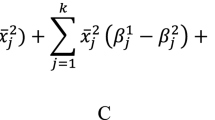Conclusion
This paper introduced a method of calculating the proportion, and its standardized index, of the GINI coefficient that is due to the overlapping of the incomes of different groups in a population. This Lorenz curvebased index measures the degree to which all groups, collectively, form different strata in a population as opposed to the degree to which an individual group forms a stratum in the population. It is useful for describing the degree of integration or segregation in a population as opposed to the degree of integration or segregation of a group within a population.
The new index was applied to distributions of wage and salary income for individuals and family income for households. The results indicate that racial/ethnic income stratification is more marked among men than women.
Similar content being viewed by others
References
Boisso, Dale; Kathy Hayes; Joseph Hirschberg; Jacques Silber, 1994, Occupational Segregation in the Multidimensional Case: Decomposition and Tests of Significance. Journal of Econometrics 61 (1); 161–72.
Bourguignon, Francois, 1979, Decomposable Income Inequality Measures., Econometrica 47(4): 901–20.
Dagum, Camilo. 1997. A New Approach to the Decomposition of the Gini Income Inequality Ratio. Empirical Economics 22:515–31.
Kuby, Michael, and Neil Reid, 1992, Technological Change and the Concentration of the U.S. General Cargo Port System, 1970–88. Economic Geography 68 (3): 272–90.
Lambert, Peter, and Richard Aronson, 1993, Inequality Decomposition Analysis and the GINI Coefficient Revisited. The Economic Journal 103(3): 1221–27.
Lerman, Robert, and Shlomo Yitzhaki, 1984, A Note on the Calculation and Interpretation of the GINI Index. Economic Letters 15: 363–68.
Mookherjee, Dilip, and Anthony Shorrocks, 1982, A Decomposition Analysis of the Trend in UK Income Inequality., The Economic Journal 92 (4): 886–902
Plotnich, Robert, 1981. A Measure of Horizontal Inequity. Review of Economics and Statistics 63: 283–88.
Plotnick, Robert. 1982. The Concept and Measurement of Horizontal Inequity. Journal of Public Economics 17: 373–91.
Pyatt, Graham, 1976. On the Interpretation and Disaggregation of GINI Coefficients., The Economic Journal 86: 243–55.
Sastry, D. and Ujwala Kelkar, 1994. Note on the Decomposition of Gini Inequality. The Review of Economics and Statistics 76(3): 584–86.
Shorrocks, Anthony, 1980. The Class of Additively Decomposable Inequality Measures. Econometrica 48(3): 613–25.
Silber, Jacques, 1989, Factor Components, Population Subgroups, and the Computation of the GINI Index of Inequality, The Review of Economics and Statistics 71: 107–15.
Stuart, Alan, 1954, The Correlation between Variate-values and Ranks in Samples from a Continuous Distribution. British Journal of Statistical Psychology 7(1): 37–44.
U.S. Dept. of Commerce, Bureau of the Census. 1995. Census of Population and Housing, Public Use Microdata Sample: 1/1000 Sample. Ann Arbor, MI: Inter-University Consortium for Political and Social Research.
Yitzhaki, Shlomo, and Robert Lerman, 1991. Income Stratification and Income Inequality. Review of Income and Wealth 37(3): 313–29.
Yitzhaki, Shlomo, 1994. Economic Distance and Overlapping of Distributions. Journal of Econometrics 61(1): 147–59.
About this article
Cite this article
Warner, G. A lorenz curve based index of income stratification. Rev Black Polit Econ 28, 41–57 (2001). https://doi.org/10.1007/BF02717269
Issue Date:
DOI: https://doi.org/10.1007/BF02717269




